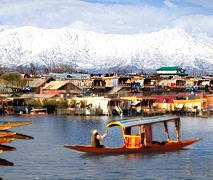 Flying into Leh, the cold desert land, over the
magnificent Himalayas is a beautiful and scary experience at once. Leh
Palace illuminated by huge halogen lamps looks like a bewitching castle
on a hilltop set ablaze in the dark nights of the Leh. Drive in the city
is as exciting as the wonders it has in its lap with the long isolated
winding road that opens up into a sheer expanse of arid flatness in
burnt sienna. There is blinding sun at the top and perhaps at the first
impression, a visitor is not likely to appreciate the blessings of the
land fully.
Flying into Leh, the cold desert land, over the
magnificent Himalayas is a beautiful and scary experience at once. Leh
Palace illuminated by huge halogen lamps looks like a bewitching castle
on a hilltop set ablaze in the dark nights of the Leh. Drive in the city
is as exciting as the wonders it has in its lap with the long isolated
winding road that opens up into a sheer expanse of arid flatness in
burnt sienna. There is blinding sun at the top and perhaps at the first
impression, a visitor is not likely to appreciate the blessings of the
land fully. Bon and Buddhism rule the lifestyle and culture of the people here. The Chortens (Stupas) and enchanting Gompas (Monasteries) adorn the city with their presence. The landscape is breathtakingly beautiful and there is an ominous beauty in the stark surroundings of Ladakh. The Hinayana Buddhist way of life lends a benevolent spirit to the very air of the region.
Location:In Ladakh that covers western J&K, India.
Significance:Capital of Ladakh
STD Code01982
Best Season
Climate
The days are dry and warm with cool winds blowing. The highest temperature is 25°C in summers and 10°C in winters while the nights are cool with temperatures ranging between 14°C and 8°C. There is heavy rainfall in winters. Recently, there has been increasing incidents of sporadic rainfall throughout the year.
How To Reach
By Air:Leh is connected by the regular domestic flights to and from Delhi. However, as the weather is unpredictable, a 2 to 3 hrs hold-up is normal, especially on the early morning departures.
By Train:The nearest railway station is in Kalka from where has to take a bus or taxi to Manali via Shimla. There are regular Tata Sumo and bus services in Manali to and from Leh.
By Road:Long, winding but well maintained roads are the next best option to a flight for Leh. The two popular routes to Leh are from Srinagar via Kargil on the Srinagar-Leh Highway and from Manali via Sarchu and Dharchu on the Manali-Leh Highway. These routes are only open from June to October.
However, it is a long and tiring journey of two days, the only comforts being the spectacular sights of the mountain country, alluring blue rivers and the passes over 13,000 ft that takes us to our destination. The respective night halts on the two routes are Kargil and Sarchu. There are regular bus and Tata Sumo services to Leh. Leh Bus Stand is barely a kilometer from the city itself.
What to wear
In summers, light cotton clothes are advisable while you will need heavy woolen clothes in winters. Wind-sheeters or raincoats as a safety against rainfall or snowfall and good waterproof shoes are needed while trekking. A warm sleeping bag will be an added advantage.
Shopping Attractions:
Kashmiris displaying their beautiful carpets and rugs adorned with a mixture of Kashmiri and Persian motifs dominate the shopping areas. There are a number of German bakeries in Leh to cater to European tastes. Special Tibetan refugee markets are the other dominant shopping centers in Leh. The turquoise from Tibet, the rubies from Burma and the Lapis Lazuli from Afghanistan along with the native Thangka paintings make up a shopping buff's day. T-shirts with 'Free Tibet' printed in them and painted masks and jewellery made from semi-precious stones or fake stones are other attractions.
Metalware is the Tibetan specialty as is the quartz that comes all the way from South India, which seems a little strange. Silverware, cymbals with special religious motifs that are used during meditation, decorative copper and brass trumpets, sonorous bowls made of nine metals like cymbals, chunky shell bangles worn by Ladakhi women and exquisite unpolished turquoise and silver jewelry are some of the highlights of the place.
Prime Attractions:
Leh Palace
Set on a small hill, Leh Palace towers above the town. It once the thriving royal residence of the ruling Namgyals and is said to have served as the model for the Potala, its more illustrious cousin in Lhasa and one-time residence of the Dalai Lama. A millennium-old, seven-storeyed structure in mud and stone, it is mesmerizing to wander through the crumbling remnants of royalty and watch the brilliant Thangkas on its soot-stained walls.
Stok Palace
Located in a tiny village on the outskirts of Leh, this palace has been the Ladakhi royal family's residence for the last 150 years since the Dogra armies invaded the Leh Palace. One may have a chance encounter with the royals here too. It houses a museum, which is said to have the best collection of exquisite Thangka paintings in the whole of Ladakh. The other things housed here are crown jewels, dresses, coins, peraks encrusted with turquoise and lapis lazuli as well as religious objects.
The Gompa Run
Gompas or traditional Buddhist monasteries and chortens or the smaller, whitewashed stupas form the ever-present features of the stark expanse of Ladakh. The two popular Gompa routes are: -
· The Leh-Manali Highway covering Shey, Thiksey and Hemis, and
· The Srinagar-Leh Highway covering Spituk, Basgo and Alchi. One may also cover Ridzong and Lamayuru on this route.










